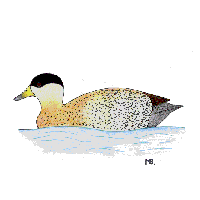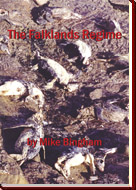 |
 |
| |
|
|
Silver Teal Local Name: Pampa Teal Breeding Range: Falkland Islands,
Chile and Argentina The Silver Teal is widespread around the Falklands, although not particularly common. It is generally restricted to ponds with well established aquatic vegetation where it forages by dabbling. Food comprises of a variety of aquatic invertebrates and pond weed. Nests of grass are hidden in dense vegetation close to the water's edge, with 5 to 10 eggs being laid between October and December. Young leave the nest at an early age, and feed themselves under the protection of the parents. Most chicks have fledged by February, and there is no double brooding. Silver Teal are most common in areas which have an abundance of well established ponds, such as Lafonia, where small flocks of adults are often found. Sexes are similar in appearance. They are easily distinguished from other water fowl by the distinctive plumage. |
|
|
||||||||||||||||||||||||||||




